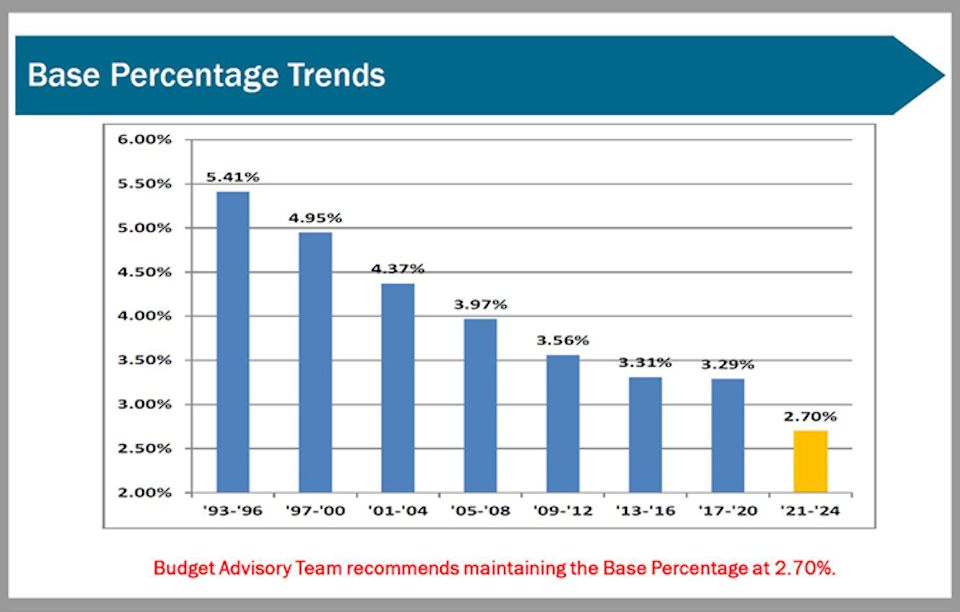For now, leaders of the General Council on Finance and Administration propose cutting the budget for denomination-wide ministries by nearly a third, starting in 2023.
HEATHER HAHN
UM News
What do a predicted denominational split and an unpredictable pandemic mean for The United Methodist Church’s bottom line?
The General Council on Finance and Administration board grappled with that question as members revisited the denomination-wide budget that will go before the coming General Conference.
The finance agency leaders already was preparing to send the lawmaking assembly the lowest budget in more than 30 years. On Dec. 1, by an 18-1 vote, the board approved shrinking the proposed four-year budget even further to a total of about $407.3 million for the years 2023-2026.
That marks a cut of nearly 33% — a third — from the budget General Conference approved in 2016 to support denomination-wide ministries.
The current proposal also would be the lowest budget submitted to General Conference since 1988, according to the denomination’s Commission on Archives and History. At the time, the denomination had about 3 million fewer members than today and had yet to establish Africa University, now supported by denominational funds.
Still, board leaders stressed that the budget proposal remains very much a work in progress and could change further.
They are trying to get a clear picture of what the denomination’s financial base will look like in the near future — and a fog of unknowns clouds their view.
After decades of intensifying debate over LGBTQ inclusion, the coming General Conference faces multiple proposals for a denominational separation.
But no person knows how many congregations will depart if a plan of separation passes. Similarly, no one can say when the deadly pandemic will stop upending lives.
“They are projections for things we’ve never done before,” said Christine Dodson, GCFA board vice president who serves on the denomination’s Budget Advisory Team. She also is the treasurer and business manager of the North Carolina Conference.
“We don’t have data on how a pandemic and disaffiliation are going to impact our churches moving forward.”
The board does have the educated guesses by leaders of U.S. conferences, the regional bodies that provide the lion’s share of funding for denomination-wide ministries. Both in 2020 and this year, GCFA surveyed conference treasurers, bishops, district superintendents, and others to get their best sense of the financial impact of congregational disaffiliations.
Based on this year’s survey, the finance agency now estimates the denomination stands to lose about 25.5% of U.S. local church net expenditures by 2025. That’s a bigger loss than projected in last year’s survey, which only asked for estimates through 2024.

The survey results do not mean that conferences expect more than a quarter of U.S. United Methodist churches to depart or close during the next four years. Net expenditures can vary widely by congregation and by circumstance.
What the results do mean is that conference leaders forecast that church departures and closures will result in a substantial decline in one of the key factors used in determining the denomination’s budget.
As it stands, some churches already are leaving without waiting for General Conference to act.
GCFA reports that in 2020, 32 U.S. congregations disaffiliated from The United Methodist Church. But that represents only a tiny fraction of the denomination’s more than 31,000 United Methodist churches nationwide.
The Rev. Steve Court, GCFA board member and former director of connectional ministries for the East Ohio Conference, told the board that he thought the net-expenditure estimates might be overly negative about what the future holds.
“I just want to keep highlighting that because it has real ministry impacts about the level of cutting that we do at this point,” he said.
North Texas Conference Bishop Mike McKee, GCFA board president, agreed with Court that the estimates were far from definitive. McKee said conference leaders tend to answer the disaffiliation question very differently depending on their role.
“This is going to be very difficult to forecast,” McKee said. “I’m of the opinion that people will walk more than churches will.”
However, he added, that he does not know of any better way to make budget projections.
The budget General Conference approves is apportioned to conferences, which in turn ask for apportionments — shares of giving — from their local churches.
GCFA requests apportionments from each U.S. conference based on a formula that includes its local church net expenditures, the economic strength of the conference and a base percentage approved by General Conference.
The GCFA board is asking the coming General Conference to drop the economic-strength part of the formula and substantially reduce the base percentage.
Budget planning is a multistep process, and the GCFA board’s votes on Dec. 1 represent just a start. The next step is allocations.
Apportionments support seven denominational funds.
On Dec. 1, the GCFA board made recommendations on the distribution of two — the Episcopal Fund, which supports the bishops, and the General Administration Fund, which supports General Conference, the Judicial Council, Archives and History, and the finance agency itself.
Now, it’s up to the Connectional Table, a church leadership body, to recommend allocations among the five other funds.
Those funds include the Ministerial Education Fund, which supports United Methodist seminaries and clergy development; the Black College Fund, which supports 11 historically Black church-affiliated schools; the Africa University Fund, and the Interdenominational Cooperation Fund, which supports ecumenical work. The largest is the World Service Fund, which supports the work of eight general church agencies and the Connectional Table itself. The World Service Fund also supports the work of United Methodist News.
Under the current budget proposal, the Connectional Table has about $294.8 million to distribute among those five funds. That’s about 37% less than allocated to the five funds under the budget approved by the 2016 General Conference.
The Connectional Table plans to bring its revised allocations to a joint meeting with the GCFA board in May 2022.
The Economic Advisory Committee, a group of United Methodist financial forecasters, will next consider updating projections in June.
Based on those projections, the GCFA board and Connectional Table usually continue to make budget adjustments up until General Conference meets.
Ultimately, General Conference has the final say on the shape of the denominational budget.
Last Updated on November 1, 2023

